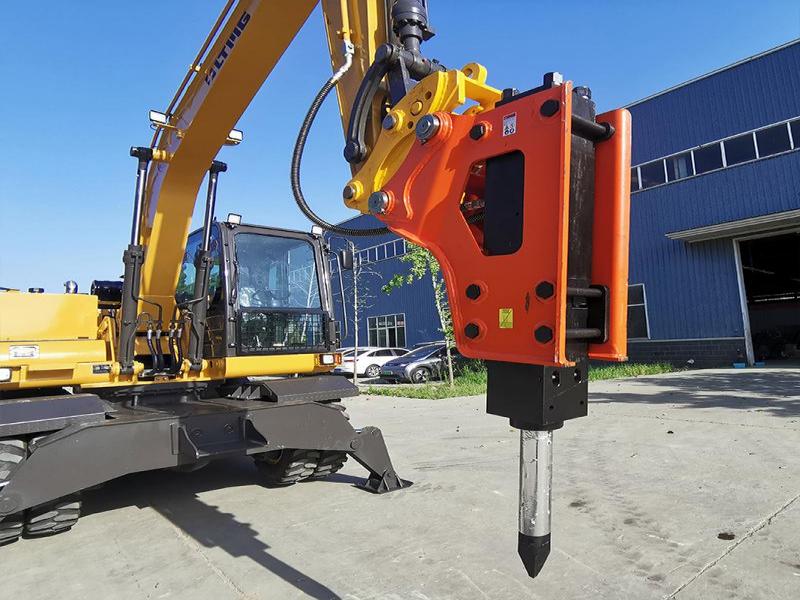Essential Maintenance Tips for Excavator Hydraulic Breakers
Aug 06, 2024
The hydraulic breaker is a vital attachment for excavators, significantly enhancing their efficiency in breaking stones and rocks during construction. It is widely used in mining, metallurgy, transportation, railways, tunnels, and other construction fields. However, due to harsh working environments and improper usage, hydraulic breakers often experience issues such as decreased impact frequency and reduced impact force. Here, we explore common failures of hydraulic breakers and their solutions.
1. Decreased Frequency
The main reasons for a decrease in the impact frequency of a hydraulic breaker include insufficient pressure or flow in the hydraulic system, loosened chisels, worn hydraulic seals, contaminated hydraulic grease, and malfunctioning safety valves.
Solution:
- Inspect the hydraulic pump and adjust the pressure or flow to control the hammer effectively.
- Check the hydraulic circuit to prevent blockages that could affect the breaker’s impact frequency.
- Replace worn components and ensure the chisel is tightly secured.
2. Reduced Impact Force
Reduced impact force can result from hydraulic circuit leaks, insufficient control bolt travel in the breaker, clogged hydraulic circuits, and excessively high hydraulic oil temperatures, leading to decreased impact force and insufficient impact stroke.
Solution:
- Inspect and adjust the hydraulic system and nitrogen pressure.
- If components have poor sealing, grind or replace the parts.
- Clean the hydraulic circuits thoroughly.
3. Inconsistent Operation
Inconsistent operation may be caused by three main issues:
- Blocked hydraulic circuits leading to poor oil flow and unstable piston power.
- Insufficient hydraulic system pressure, incorrect directional valve settings, seized pistons, and malfunctioning check valves causing impact delays.
- Chisels getting stuck, affecting the continuity and periodicity of the breaker.
Solution:
- Inspect and clean or replace blocked hydraulic circuits.
- Focus on the oil pipe interfaces, directional valve settings, check valves, and pistons.
- Inspect and adjust the chisel’s condition, grind with a whetstone if necessary, and ensure timely lubrication.
4. Oil Leaks
Oil leaks primarily occur due to excessive wear of seals and decreased sealing effectiveness, or loose hydraulic pipe joints.
Solution:
- Replace the corresponding seals based on the leak’s location.
- Tighten the hydraulic pipe joints.
5. Abnormal Hydraulic Pipe Vibration
Abnormal vibrations in the hydraulic pipes can be caused by gas leakage in the accumulator or reduced nitrogen pressure in the breaker handle body.
Solution:
- Inspect the accumulator’s gas pressure and check for diaphragm damage if pressure cannot be maintained.
- Adjust the nitrogen pressure in the breaker to maintain balance.
Impact of Environmental Factors on Hydraulic Breaker Failure Rates and Countermeasures
Environmental factors significantly influence the failure rates of hydraulic breakers, mainly in the following aspects:
1. Temperature and Humidity:
- Temperature and humidity variations can affect hydraulic breaker performance. High temperatures may reduce hydraulic oil viscosity, impacting system sealing and lubrication, increasing oil leakage risks. High humidity accelerates metal component corrosion, shortening fatigue life and causing cracks.
2. Chemical Exposure:
- In some environments, hydraulic breakers may be exposed to chemicals like acids and alkalis, which corrode equipment materials, reducing mechanical strength and durability. For example, dust and harmful gases in mining operations can damage seals and accelerate wear.
3. Improper Operation:
- Incorrect operation increases failure rates. Using breakers in water or muddy conditions can loosen or break bolts. Frequent impacts and chisel shaking can damage the breaker’s main structure.
Countermeasures:
1. Improving Sealing Performance:
- Ensure high-quality hydraulic seals and regularly check and replace wear-prone parts to prevent oil leaks and other hydraulic system failures.
2. Optimizing Design and Construction:
- Implement protective measures like dust covers and nets during design and construction to reduce dust impact. Plan work environments reasonably to avoid operations under adverse weather conditions.
3. Regular Maintenance and Inspection:
- Establish comprehensive maintenance and inspection systems to regularly check and maintain breakers, identifying and addressing potential issues promptly. Regularly check hydraulic oil cleanliness and viscosity to ensure optimal working conditions.
4. Operator Training:
- Enhance operator training to improve their awareness of proper equipment operation, preventing failures due to improper use.
Common causes of hydraulic breaker failures include blocked hydraulic circuits, excessively worn valve seals, and abnormal hydraulic or pneumatic pressures. Since breakers consist of a series of precision components, improper use can easily cause the aforementioned failures. Therefore, adopting good usage habits and conducting frequent inspections and maintenance can prevent potential problems and avoid unnecessary losses.
